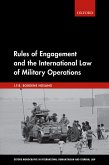32,95 €
32,95 €
inkl. MwSt.
Sofort per Download lieferbar

16 °P sammeln
32,95 €
Als Download kaufen

32,95 €
inkl. MwSt.
Sofort per Download lieferbar

16 °P sammeln
Jetzt verschenken
Alle Infos zum eBook verschenken
32,95 €
inkl. MwSt.
Sofort per Download lieferbar
Alle Infos zum eBook verschenken

16 °P sammeln
- Format: PDF
- Merkliste
- Auf die Merkliste
- Bewerten Bewerten
- Teilen
- Produkt teilen
- Produkterinnerung
- Produkterinnerung

Bitte loggen Sie sich zunächst in Ihr Kundenkonto ein oder registrieren Sie sich bei
bücher.de, um das eBook-Abo tolino select nutzen zu können.
Hier können Sie sich einloggen
Hier können Sie sich einloggen
Sie sind bereits eingeloggt. Klicken Sie auf 2. tolino select Abo, um fortzufahren.

Bitte loggen Sie sich zunächst in Ihr Kundenkonto ein oder registrieren Sie sich bei bücher.de, um das eBook-Abo tolino select nutzen zu können.
This book, now fully updated and in its third edition, explains the law relating to the conduct of hostilities and provides guidance on difficult or controversial aspects of the law. It covers who or what may legitimately be attacked and what precautions must be taken to protect civilians, cultural property or the natural environment. It deals with the responsibility of commanders and how the law is enforced. There are also chapters on internal armed conflicts and the security aspects of belligerent occupation.
- Geräte: PC
- mit Kopierschutz
- eBook Hilfe
- Größe: 3.13MB
Andere Kunden interessierten sich auch für
![Prosecutorial Discretion in the International Criminal Court (eBook, PDF) Prosecutorial Discretion in the International Criminal Court (eBook, PDF)]() Farid Mohammed RashidProsecutorial Discretion in the International Criminal Court (eBook, PDF)44,95 €
Farid Mohammed RashidProsecutorial Discretion in the International Criminal Court (eBook, PDF)44,95 €![The International Game of Power (eBook, PDF) The International Game of Power (eBook, PDF)]() Peter BernholzThe International Game of Power (eBook, PDF)77,95 €
Peter BernholzThe International Game of Power (eBook, PDF)77,95 €![The Concept of Race in International Criminal Law (eBook, PDF) The Concept of Race in International Criminal Law (eBook, PDF)]() Carola LingaasThe Concept of Race in International Criminal Law (eBook, PDF)42,95 €
Carola LingaasThe Concept of Race in International Criminal Law (eBook, PDF)42,95 €![The International Covenant on Civil and Political Rights (eBook, PDF) The International Covenant on Civil and Political Rights (eBook, PDF)]() Sarah JosephThe International Covenant on Civil and Political Rights (eBook, PDF)60,95 €
Sarah JosephThe International Covenant on Civil and Political Rights (eBook, PDF)60,95 €![Rules of Engagement and the International Law of Military Operations (eBook, PDF) Rules of Engagement and the International Law of Military Operations (eBook, PDF)]() J. F. R. Boddens HosangRules of Engagement and the International Law of Military Operations (eBook, PDF)81,95 €
J. F. R. Boddens HosangRules of Engagement and the International Law of Military Operations (eBook, PDF)81,95 €![International Law and the Reconceptualization of Territorial Boundaries (eBook, PDF) International Law and the Reconceptualization of Territorial Boundaries (eBook, PDF)]() Joshua CastellinoInternational Law and the Reconceptualization of Territorial Boundaries (eBook, PDF)42,95 €
Joshua CastellinoInternational Law and the Reconceptualization of Territorial Boundaries (eBook, PDF)42,95 €![International Law and the Arctic (eBook, PDF) International Law and the Arctic (eBook, PDF)]() Michael ByersInternational Law and the Arctic (eBook, PDF)27,95 €
Michael ByersInternational Law and the Arctic (eBook, PDF)27,95 €-
-
-
This book, now fully updated and in its third edition, explains the law relating to the conduct of hostilities and provides guidance on difficult or controversial aspects of the law. It covers who or what may legitimately be attacked and what precautions must be taken to protect civilians, cultural property or the natural environment. It deals with the responsibility of commanders and how the law is enforced. There are also chapters on internal armed conflicts and the security aspects of belligerent occupation.
Dieser Download kann aus rechtlichen Gründen nur mit Rechnungsadresse in A, D ausgeliefert werden.
Produktdetails
- Produktdetails
- Verlag: Princeton University Press
- Seitenzahl: 432
- Erscheinungstermin: 4. Juni 2024
- Englisch
- ISBN-13: 9781526184054
- Artikelnr.: 70894241
- Verlag: Princeton University Press
- Seitenzahl: 432
- Erscheinungstermin: 4. Juni 2024
- Englisch
- ISBN-13: 9781526184054
- Artikelnr.: 70894241
- Herstellerkennzeichnung Die Herstellerinformationen sind derzeit nicht verfügbar.
A. P. V. Rogers is a Former Senior Fellow at the Lauterpacht Centre for International Law at the University of Cambridge
1 General principles Armed conflict Military necessity Humanity Rule of
distinction Civilians and combatants Taking a direct part in hostilities
Civilian property and military targets Civilians and civilian objects
protected Rule of proportionality Indiscriminate attacks Customary law
Treaty law Definition of attack 2 Enemy armed forces I Good faith Who is a
member of the enemy armed forces? Child fighters Perfidy and ruses of war
Perfidy Ruses of war Difference between perfidy and ruses of war Tactics:
ambush, sniping, sabotage Uniform Use of enemy uniform Misuse of emblems
Intelligence gathering Assassination Outlawry Psychological warfare II
Humanity Attacking food and water used by members of enemy armed forces
Surrender Safeguard of persons hors de combat Occupants of aircraft and
vehicles Quarter Unusual conditions of combat Wounded, sick and dead
Prisoners of war Humane treatment Maintenance and medical treatment
Searching Security Interrogation Evacuation 3 Wounded, sick and shipwrecked
The Geneva emblem Objects of protection The wounded, sick, shipwrecked,
dead and missing Medical units Medical personnel Protection Identification
Retained personnel Use of arms Duties Medical installations and equipment
Medical transports General protection Medical aircraft Medical ships and
craft Neutrality law and the wounded and sick Religious personnel Hospital
and safety zones 4 Military objectives Current Law The Gulf war 1991 Kosovo
1999 A reappraisal of the definition of military objectives? Afghanistan
2001 Iraq 2003 Television stations as targets Conclusions Examples of
military objectives Objects protected from attack 5 Precautions in attack
The Hague Regulations Destruction or damage Non-combatants Warnings Assault
Bombardment Necessary steps Precautions Air Warfare Rules Greco-German
Mixed Arbitral Tribunal Second World War Practice Air warfare Monte Cassino
Events From 1945 to1977 Current Law Precautions in attack 'Attack' and
'feasible' Precautions 'Concrete and direct' Warning 'Unless circumstances
do not permit' Sieges The Gulf war 1991 Allied bombing campaign Kosovo 1999
Air-war targeting Afghanistan 2001 Iraq 2003 Legal responsibilities in
practice General principles Levels of responsibility Conclusions
Guidelines: offensive operations checklist Practicalities 6 Precautions
against the effects of attacks Current Law Precautions against the effects
of attacks Remove civilians and civilian objects Avoid densely populated
areas Protect civilians Feasible Own territory Using civilians to shield
military objects or operations Failure of defenders; position of attackers
Civil defence Zones Other protected objects Open or undefended towns 7
Cultural property Protected property The Hague Regulations Air Warfare
Rules Roerich Pact Draft convention of 1939 Second World War practice
Cultural Property Cultural Property Convention Scope of application
Definition Basic protection Special protection Enhanced protection Waiver
of protection Precautions in attack Precautions in defence Occupation
Transports Personnel Protective emblem Supervision Enforcement Measures for
compliance Sending and receiving states Discussion Cultural property and
places of worship Protocol I Discussion ICC Statute Dubrovnik Iraq The
definition of cultural property Conclusions 8 Environmental Protection
Current Law Property protection Environmental protection ENMOD Convention
Protocol I Relationship between the ENMOD Convention and Protocol I Other
provisions of Protocol I Particular weapons Conventional weapons Mines and
other remnants of war Nuclear weapons Incendiary weapons Chemical and
biological weapons Fuel-air explosive Depleted uranium Effect on neutral
states Iraq Oil pollution Nuclear facilities Diverting rivers Depleted
uranium Evaluation Conclusions The future 9 Belligerent occupation I
Authority over occupied territory Transition for war fighting to occupation
Commencement of occupation Temporary nature of occupation Legal position of
parties Human rights law Duties and rights of the occupying power Duties
and rights of the population Termination of occupation Postscript on Iraq
II Security issues Withdrawal of right of communication Powers relating to
property Use or requisitioning of private property? Destruction of property
Compulsory labour Rationing Blockade Evacuation Deportations and transfers
Settlements Reprisals Hostage taking Policing, riot control; resistance
Short-term detention and interrogation Trial and punishment Assigned
residence and internment Conditions of internment Security barriers 10 The
conduct of hostilities in internal armed conflicts Law applicable Existence
of an armed conflict Types of internal armed conflict The conduct of
hostilities in internal armed conflicts Enemy armed forces Civilian
immunity Forced movement of civilians Military objectives and civilian
objects Precautions in attack Precautions against the effects of attacks `
Cultural property Environmental protection Criminal responsibility
Belligerent reprisals Internal armed conflicts, a summary of the rules 11
Command Responsibility The war crimes trials Exception for detail
Assumption of legality of orders not obviously unlawful Duty to prevent
crimes Duty to take steps Knowledge Ignorance of reports Cases where
commander put on notice Proof of knowledge, summary Offences by persons not
under command Duty/liability Evidence Staff officers Protocol I The
commander's responsibility for war crimes committed by his subordinates
(Protocol I, Art. 86, para. 2) Duty of commanders to deal with breaches
(Protocol I, Art. 87, para. 3) Recent developments ICTY Statute ICC Statute
Conclusions Military discipline and superior orders 12 Implementation and
enforcement of the law of war I Implementation Practice Command influence
Reciprocity Hostage taking prohibited Nuremberg principles Legal mechanisms
Belligerent reprisals Training and dissemination International assistance
International co-operation Fact-finding and inquiries International
Committee of the Red Cross Compensation II Enforcement War crimes and grave
breaches War crimes Grave breaches War crimes and internal armed conflict
Criminal responsibility Individual criminal responsibility Responsibility
of commanders Responsibility of states Mental element of war crimes
Defences to war crimes charges Accident Duress Ignorance of law Mistake of
fact Superior orders International Criminal Court III The contribution of
the military lawyer Negotiator Manual Writer Instructor Legal adviser Some
legal aspects of peace support operations Prosecutor Final remarks
Bibliography
distinction Civilians and combatants Taking a direct part in hostilities
Civilian property and military targets Civilians and civilian objects
protected Rule of proportionality Indiscriminate attacks Customary law
Treaty law Definition of attack 2 Enemy armed forces I Good faith Who is a
member of the enemy armed forces? Child fighters Perfidy and ruses of war
Perfidy Ruses of war Difference between perfidy and ruses of war Tactics:
ambush, sniping, sabotage Uniform Use of enemy uniform Misuse of emblems
Intelligence gathering Assassination Outlawry Psychological warfare II
Humanity Attacking food and water used by members of enemy armed forces
Surrender Safeguard of persons hors de combat Occupants of aircraft and
vehicles Quarter Unusual conditions of combat Wounded, sick and dead
Prisoners of war Humane treatment Maintenance and medical treatment
Searching Security Interrogation Evacuation 3 Wounded, sick and shipwrecked
The Geneva emblem Objects of protection The wounded, sick, shipwrecked,
dead and missing Medical units Medical personnel Protection Identification
Retained personnel Use of arms Duties Medical installations and equipment
Medical transports General protection Medical aircraft Medical ships and
craft Neutrality law and the wounded and sick Religious personnel Hospital
and safety zones 4 Military objectives Current Law The Gulf war 1991 Kosovo
1999 A reappraisal of the definition of military objectives? Afghanistan
2001 Iraq 2003 Television stations as targets Conclusions Examples of
military objectives Objects protected from attack 5 Precautions in attack
The Hague Regulations Destruction or damage Non-combatants Warnings Assault
Bombardment Necessary steps Precautions Air Warfare Rules Greco-German
Mixed Arbitral Tribunal Second World War Practice Air warfare Monte Cassino
Events From 1945 to1977 Current Law Precautions in attack 'Attack' and
'feasible' Precautions 'Concrete and direct' Warning 'Unless circumstances
do not permit' Sieges The Gulf war 1991 Allied bombing campaign Kosovo 1999
Air-war targeting Afghanistan 2001 Iraq 2003 Legal responsibilities in
practice General principles Levels of responsibility Conclusions
Guidelines: offensive operations checklist Practicalities 6 Precautions
against the effects of attacks Current Law Precautions against the effects
of attacks Remove civilians and civilian objects Avoid densely populated
areas Protect civilians Feasible Own territory Using civilians to shield
military objects or operations Failure of defenders; position of attackers
Civil defence Zones Other protected objects Open or undefended towns 7
Cultural property Protected property The Hague Regulations Air Warfare
Rules Roerich Pact Draft convention of 1939 Second World War practice
Cultural Property Cultural Property Convention Scope of application
Definition Basic protection Special protection Enhanced protection Waiver
of protection Precautions in attack Precautions in defence Occupation
Transports Personnel Protective emblem Supervision Enforcement Measures for
compliance Sending and receiving states Discussion Cultural property and
places of worship Protocol I Discussion ICC Statute Dubrovnik Iraq The
definition of cultural property Conclusions 8 Environmental Protection
Current Law Property protection Environmental protection ENMOD Convention
Protocol I Relationship between the ENMOD Convention and Protocol I Other
provisions of Protocol I Particular weapons Conventional weapons Mines and
other remnants of war Nuclear weapons Incendiary weapons Chemical and
biological weapons Fuel-air explosive Depleted uranium Effect on neutral
states Iraq Oil pollution Nuclear facilities Diverting rivers Depleted
uranium Evaluation Conclusions The future 9 Belligerent occupation I
Authority over occupied territory Transition for war fighting to occupation
Commencement of occupation Temporary nature of occupation Legal position of
parties Human rights law Duties and rights of the occupying power Duties
and rights of the population Termination of occupation Postscript on Iraq
II Security issues Withdrawal of right of communication Powers relating to
property Use or requisitioning of private property? Destruction of property
Compulsory labour Rationing Blockade Evacuation Deportations and transfers
Settlements Reprisals Hostage taking Policing, riot control; resistance
Short-term detention and interrogation Trial and punishment Assigned
residence and internment Conditions of internment Security barriers 10 The
conduct of hostilities in internal armed conflicts Law applicable Existence
of an armed conflict Types of internal armed conflict The conduct of
hostilities in internal armed conflicts Enemy armed forces Civilian
immunity Forced movement of civilians Military objectives and civilian
objects Precautions in attack Precautions against the effects of attacks `
Cultural property Environmental protection Criminal responsibility
Belligerent reprisals Internal armed conflicts, a summary of the rules 11
Command Responsibility The war crimes trials Exception for detail
Assumption of legality of orders not obviously unlawful Duty to prevent
crimes Duty to take steps Knowledge Ignorance of reports Cases where
commander put on notice Proof of knowledge, summary Offences by persons not
under command Duty/liability Evidence Staff officers Protocol I The
commander's responsibility for war crimes committed by his subordinates
(Protocol I, Art. 86, para. 2) Duty of commanders to deal with breaches
(Protocol I, Art. 87, para. 3) Recent developments ICTY Statute ICC Statute
Conclusions Military discipline and superior orders 12 Implementation and
enforcement of the law of war I Implementation Practice Command influence
Reciprocity Hostage taking prohibited Nuremberg principles Legal mechanisms
Belligerent reprisals Training and dissemination International assistance
International co-operation Fact-finding and inquiries International
Committee of the Red Cross Compensation II Enforcement War crimes and grave
breaches War crimes Grave breaches War crimes and internal armed conflict
Criminal responsibility Individual criminal responsibility Responsibility
of commanders Responsibility of states Mental element of war crimes
Defences to war crimes charges Accident Duress Ignorance of law Mistake of
fact Superior orders International Criminal Court III The contribution of
the military lawyer Negotiator Manual Writer Instructor Legal adviser Some
legal aspects of peace support operations Prosecutor Final remarks
Bibliography
1 General principles Armed conflict Military necessity Humanity Rule of
distinction Civilians and combatants Taking a direct part in hostilities
Civilian property and military targets Civilians and civilian objects
protected Rule of proportionality Indiscriminate attacks Customary law
Treaty law Definition of attack 2 Enemy armed forces I Good faith Who is a
member of the enemy armed forces? Child fighters Perfidy and ruses of war
Perfidy Ruses of war Difference between perfidy and ruses of war Tactics:
ambush, sniping, sabotage Uniform Use of enemy uniform Misuse of emblems
Intelligence gathering Assassination Outlawry Psychological warfare II
Humanity Attacking food and water used by members of enemy armed forces
Surrender Safeguard of persons hors de combat Occupants of aircraft and
vehicles Quarter Unusual conditions of combat Wounded, sick and dead
Prisoners of war Humane treatment Maintenance and medical treatment
Searching Security Interrogation Evacuation 3 Wounded, sick and shipwrecked
The Geneva emblem Objects of protection The wounded, sick, shipwrecked,
dead and missing Medical units Medical personnel Protection Identification
Retained personnel Use of arms Duties Medical installations and equipment
Medical transports General protection Medical aircraft Medical ships and
craft Neutrality law and the wounded and sick Religious personnel Hospital
and safety zones 4 Military objectives Current Law The Gulf war 1991 Kosovo
1999 A reappraisal of the definition of military objectives? Afghanistan
2001 Iraq 2003 Television stations as targets Conclusions Examples of
military objectives Objects protected from attack 5 Precautions in attack
The Hague Regulations Destruction or damage Non-combatants Warnings Assault
Bombardment Necessary steps Precautions Air Warfare Rules Greco-German
Mixed Arbitral Tribunal Second World War Practice Air warfare Monte Cassino
Events From 1945 to1977 Current Law Precautions in attack 'Attack' and
'feasible' Precautions 'Concrete and direct' Warning 'Unless circumstances
do not permit' Sieges The Gulf war 1991 Allied bombing campaign Kosovo 1999
Air-war targeting Afghanistan 2001 Iraq 2003 Legal responsibilities in
practice General principles Levels of responsibility Conclusions
Guidelines: offensive operations checklist Practicalities 6 Precautions
against the effects of attacks Current Law Precautions against the effects
of attacks Remove civilians and civilian objects Avoid densely populated
areas Protect civilians Feasible Own territory Using civilians to shield
military objects or operations Failure of defenders; position of attackers
Civil defence Zones Other protected objects Open or undefended towns 7
Cultural property Protected property The Hague Regulations Air Warfare
Rules Roerich Pact Draft convention of 1939 Second World War practice
Cultural Property Cultural Property Convention Scope of application
Definition Basic protection Special protection Enhanced protection Waiver
of protection Precautions in attack Precautions in defence Occupation
Transports Personnel Protective emblem Supervision Enforcement Measures for
compliance Sending and receiving states Discussion Cultural property and
places of worship Protocol I Discussion ICC Statute Dubrovnik Iraq The
definition of cultural property Conclusions 8 Environmental Protection
Current Law Property protection Environmental protection ENMOD Convention
Protocol I Relationship between the ENMOD Convention and Protocol I Other
provisions of Protocol I Particular weapons Conventional weapons Mines and
other remnants of war Nuclear weapons Incendiary weapons Chemical and
biological weapons Fuel-air explosive Depleted uranium Effect on neutral
states Iraq Oil pollution Nuclear facilities Diverting rivers Depleted
uranium Evaluation Conclusions The future 9 Belligerent occupation I
Authority over occupied territory Transition for war fighting to occupation
Commencement of occupation Temporary nature of occupation Legal position of
parties Human rights law Duties and rights of the occupying power Duties
and rights of the population Termination of occupation Postscript on Iraq
II Security issues Withdrawal of right of communication Powers relating to
property Use or requisitioning of private property? Destruction of property
Compulsory labour Rationing Blockade Evacuation Deportations and transfers
Settlements Reprisals Hostage taking Policing, riot control; resistance
Short-term detention and interrogation Trial and punishment Assigned
residence and internment Conditions of internment Security barriers 10 The
conduct of hostilities in internal armed conflicts Law applicable Existence
of an armed conflict Types of internal armed conflict The conduct of
hostilities in internal armed conflicts Enemy armed forces Civilian
immunity Forced movement of civilians Military objectives and civilian
objects Precautions in attack Precautions against the effects of attacks `
Cultural property Environmental protection Criminal responsibility
Belligerent reprisals Internal armed conflicts, a summary of the rules 11
Command Responsibility The war crimes trials Exception for detail
Assumption of legality of orders not obviously unlawful Duty to prevent
crimes Duty to take steps Knowledge Ignorance of reports Cases where
commander put on notice Proof of knowledge, summary Offences by persons not
under command Duty/liability Evidence Staff officers Protocol I The
commander's responsibility for war crimes committed by his subordinates
(Protocol I, Art. 86, para. 2) Duty of commanders to deal with breaches
(Protocol I, Art. 87, para. 3) Recent developments ICTY Statute ICC Statute
Conclusions Military discipline and superior orders 12 Implementation and
enforcement of the law of war I Implementation Practice Command influence
Reciprocity Hostage taking prohibited Nuremberg principles Legal mechanisms
Belligerent reprisals Training and dissemination International assistance
International co-operation Fact-finding and inquiries International
Committee of the Red Cross Compensation II Enforcement War crimes and grave
breaches War crimes Grave breaches War crimes and internal armed conflict
Criminal responsibility Individual criminal responsibility Responsibility
of commanders Responsibility of states Mental element of war crimes
Defences to war crimes charges Accident Duress Ignorance of law Mistake of
fact Superior orders International Criminal Court III The contribution of
the military lawyer Negotiator Manual Writer Instructor Legal adviser Some
legal aspects of peace support operations Prosecutor Final remarks
Bibliography
distinction Civilians and combatants Taking a direct part in hostilities
Civilian property and military targets Civilians and civilian objects
protected Rule of proportionality Indiscriminate attacks Customary law
Treaty law Definition of attack 2 Enemy armed forces I Good faith Who is a
member of the enemy armed forces? Child fighters Perfidy and ruses of war
Perfidy Ruses of war Difference between perfidy and ruses of war Tactics:
ambush, sniping, sabotage Uniform Use of enemy uniform Misuse of emblems
Intelligence gathering Assassination Outlawry Psychological warfare II
Humanity Attacking food and water used by members of enemy armed forces
Surrender Safeguard of persons hors de combat Occupants of aircraft and
vehicles Quarter Unusual conditions of combat Wounded, sick and dead
Prisoners of war Humane treatment Maintenance and medical treatment
Searching Security Interrogation Evacuation 3 Wounded, sick and shipwrecked
The Geneva emblem Objects of protection The wounded, sick, shipwrecked,
dead and missing Medical units Medical personnel Protection Identification
Retained personnel Use of arms Duties Medical installations and equipment
Medical transports General protection Medical aircraft Medical ships and
craft Neutrality law and the wounded and sick Religious personnel Hospital
and safety zones 4 Military objectives Current Law The Gulf war 1991 Kosovo
1999 A reappraisal of the definition of military objectives? Afghanistan
2001 Iraq 2003 Television stations as targets Conclusions Examples of
military objectives Objects protected from attack 5 Precautions in attack
The Hague Regulations Destruction or damage Non-combatants Warnings Assault
Bombardment Necessary steps Precautions Air Warfare Rules Greco-German
Mixed Arbitral Tribunal Second World War Practice Air warfare Monte Cassino
Events From 1945 to1977 Current Law Precautions in attack 'Attack' and
'feasible' Precautions 'Concrete and direct' Warning 'Unless circumstances
do not permit' Sieges The Gulf war 1991 Allied bombing campaign Kosovo 1999
Air-war targeting Afghanistan 2001 Iraq 2003 Legal responsibilities in
practice General principles Levels of responsibility Conclusions
Guidelines: offensive operations checklist Practicalities 6 Precautions
against the effects of attacks Current Law Precautions against the effects
of attacks Remove civilians and civilian objects Avoid densely populated
areas Protect civilians Feasible Own territory Using civilians to shield
military objects or operations Failure of defenders; position of attackers
Civil defence Zones Other protected objects Open or undefended towns 7
Cultural property Protected property The Hague Regulations Air Warfare
Rules Roerich Pact Draft convention of 1939 Second World War practice
Cultural Property Cultural Property Convention Scope of application
Definition Basic protection Special protection Enhanced protection Waiver
of protection Precautions in attack Precautions in defence Occupation
Transports Personnel Protective emblem Supervision Enforcement Measures for
compliance Sending and receiving states Discussion Cultural property and
places of worship Protocol I Discussion ICC Statute Dubrovnik Iraq The
definition of cultural property Conclusions 8 Environmental Protection
Current Law Property protection Environmental protection ENMOD Convention
Protocol I Relationship between the ENMOD Convention and Protocol I Other
provisions of Protocol I Particular weapons Conventional weapons Mines and
other remnants of war Nuclear weapons Incendiary weapons Chemical and
biological weapons Fuel-air explosive Depleted uranium Effect on neutral
states Iraq Oil pollution Nuclear facilities Diverting rivers Depleted
uranium Evaluation Conclusions The future 9 Belligerent occupation I
Authority over occupied territory Transition for war fighting to occupation
Commencement of occupation Temporary nature of occupation Legal position of
parties Human rights law Duties and rights of the occupying power Duties
and rights of the population Termination of occupation Postscript on Iraq
II Security issues Withdrawal of right of communication Powers relating to
property Use or requisitioning of private property? Destruction of property
Compulsory labour Rationing Blockade Evacuation Deportations and transfers
Settlements Reprisals Hostage taking Policing, riot control; resistance
Short-term detention and interrogation Trial and punishment Assigned
residence and internment Conditions of internment Security barriers 10 The
conduct of hostilities in internal armed conflicts Law applicable Existence
of an armed conflict Types of internal armed conflict The conduct of
hostilities in internal armed conflicts Enemy armed forces Civilian
immunity Forced movement of civilians Military objectives and civilian
objects Precautions in attack Precautions against the effects of attacks `
Cultural property Environmental protection Criminal responsibility
Belligerent reprisals Internal armed conflicts, a summary of the rules 11
Command Responsibility The war crimes trials Exception for detail
Assumption of legality of orders not obviously unlawful Duty to prevent
crimes Duty to take steps Knowledge Ignorance of reports Cases where
commander put on notice Proof of knowledge, summary Offences by persons not
under command Duty/liability Evidence Staff officers Protocol I The
commander's responsibility for war crimes committed by his subordinates
(Protocol I, Art. 86, para. 2) Duty of commanders to deal with breaches
(Protocol I, Art. 87, para. 3) Recent developments ICTY Statute ICC Statute
Conclusions Military discipline and superior orders 12 Implementation and
enforcement of the law of war I Implementation Practice Command influence
Reciprocity Hostage taking prohibited Nuremberg principles Legal mechanisms
Belligerent reprisals Training and dissemination International assistance
International co-operation Fact-finding and inquiries International
Committee of the Red Cross Compensation II Enforcement War crimes and grave
breaches War crimes Grave breaches War crimes and internal armed conflict
Criminal responsibility Individual criminal responsibility Responsibility
of commanders Responsibility of states Mental element of war crimes
Defences to war crimes charges Accident Duress Ignorance of law Mistake of
fact Superior orders International Criminal Court III The contribution of
the military lawyer Negotiator Manual Writer Instructor Legal adviser Some
legal aspects of peace support operations Prosecutor Final remarks
Bibliography







